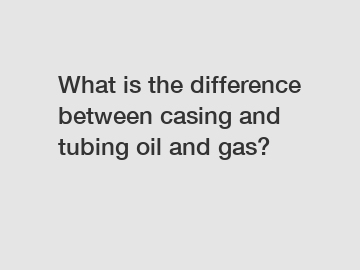What is the difference between casing and tubing oil and gas?
What is the difference between casing and tubing in the oil and gas industry?
Casing and tubing are two essential components used in the drilling and production of oil and gas wells. While they may appear similar, there are distinct differences between the two. Understanding these differences is crucial for professionals in the industry. This article aims to shed light on the dissimilarities between casing and tubing, their functions, and why these variances are essential.
1. Purpose:

Casing serves as an external protective layer for the wellbore, ensuring stability and integrity. It prevents the collapse of the wellbore walls while drilling and production activities take place. On the other hand, tubing is primarily used for fluid transportation from the well to the surface. It plays a vital role in controlling the flow of oil and gas.
2. Position:
Casing is the first protective layer installed in the wellbore. It is set by cementing it into the drilled hole, starting from the surface and proceeding to the pre-determined depth. This helps prevent the well from collapsing and isolates different formations to avoid intermixing of fluids. Tubing, however, is installed inside the casing, extending from the wellhead to the production zone. It is placed after drilling operations are completed and the well is ready for production.
3. Dimensions:
Casing is available in various sizes and grades, which are determined based on the well's specific characteristics. It typically has a large diameter, ranging from 4.5 to 20 inches, and a specified wall thickness. Tubing, on the other hand, has a smaller diameter, typically ranging from 1.05 to 4.5 inches, allowing for fluid transportation from the well to the surface.
4. Design:
Casing is designed to withstand high external pressures, ensuring the integrity of the well. It is constructed with thicker walls and heavy-duty materials, such as steel alloys, to handle the load and to prevent any leaks or damage. Tubing, however, has thinner walls and is made of materials suitable for fluid transportation, as it does not bear the same external forces as casing.
In conclusion, casing and tubing play distinct roles in the oil and gas industry. Casing provides the wellbore with structural integrity, protection against collapse, and isolates different formations. Tubing, on the other hand, facilitates fluid transportation from the well to the surface. The differences lie in their purpose, position, dimensions, and design. It is crucial for professionals in the industry to understand these disparities to ensure the proper functioning and safety of oil and gas wells.
If you are looking for more details, kindly visit Seamless Casing Pipe, oilfield tubing manufacturer, oilfield tubing supplier.


